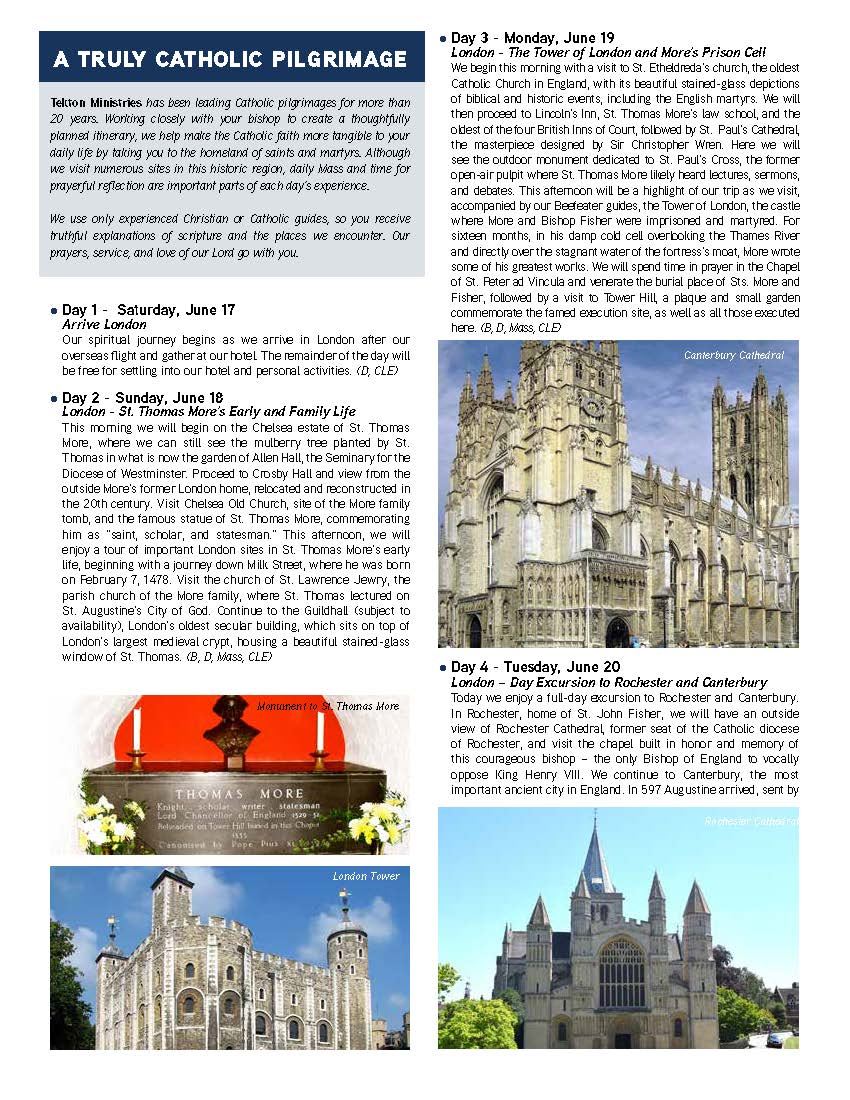|
The pilgrims arrived safely in London on Saturday, June 17. Cheerful representatives of Tekton Ministries met the various parties at Heathrow and brought them to the Tower Hotel near the City of London. The hotel enjoys a commanding view of the Tower Bridge and is a very short walk from the Tower of London, itself. Several parties’ arrivals were interrupted by the festivities for King Charles III’s birthday, which won’t actually occur until November 14 (don’t ask; it’s a British thing). Early in the day it was the trooping of the color, in which the reigning monarch rode for the first time since 1986. Later it was closure of parts of the Embankment on the Thames River to accommodate the crowds who turned out for the new King and to watch the spectacle of a 70-plane flyover, much of which had been held over from the May 6 Coronation due to inclement weather. Seeing these things, one could not help but hope that accession of a monarch known to favor the Roman Catholic Faith augurs well for its future in this great nation.
On Tuesday, June 20, the pilgrims continued their engagement with the life and writings of St. Thomas More. To help us better understand More’s actions with respect to the Act of Succession and the Act of Supremacy, instructor Lou Karlin focused his morning presentation on the importance of oaths in Tudor England. Meanwhile, co-instructor David Oakley helped us to understand better the mind of the great martyr through an analysis of Utopia, perhaps his greatest work. In particular, we studied Utopia as an exercise in analyzing contemporary manners and mores by examining their very opposites.
For the third time on this pilgrimage, Bishop Burns said Mass for the pilgrims at the Catholic Church and Shrine of St. Thomas of Canterbury. Although this was perhaps the humblest setting in which we attended Mass, it contained pearls of great price, relics of two prelates murdered in their own cathedrals, Thomas à Becket and Oscar Romero. Our hosts kindly invited us to venerate Becket’s relic, so this pilgrim touched both his wedding ring and his rosary to a reliquary containing the great martyr’s finger. We ended the day in Rochester, where we learned that the local Catholic parish, St. John Fisher, was rebuilt after World War II thanks to the generous donations of the good people of the Diocese of Rochester, New York. A visit to Rochester Cathedral offered even greater insights into the life of its former Bishop, St. John Fisher. On June 21st, Wednesday’s academic session turned the pilgrims’ attention to the Trial of Sir Thomas More, with special attention to the procedural safeguards, or lack thereof, afforded to treason defendants in those times. At the risk of distilling David and Lou’s presentations too much, it would seem that More’s conviction hinged on the Crown’s ability to compound misprision of treason, a lesser offense, into the capital crime of treason itself and on the precise meaning of “maliciously” under the treason statute. The outcome, alas, is a matter of historical record.
Mass that day was celebrated, again by the indefatigable Bishop Burns, at the Brompton Oratory, Herbert Gribble’s neo-Baroque masterpiece, associated so closely with Frederick Faber and the London Oratorians. After some free time to explore the city, we made our rendezvous at St. Lawrence Jewry, the church near his birthplace and the Guildhall where a young Thomas More delivered a seminal series of lectures on St Augustine’s City of God.
On Thursday, June 22 the pilgrims wrapped up their analysis of the trial of St. Thomas More. Shifting from procedure to the great martyr’s preparedness for his fate, we learned of the routine of prayer and contemplative writing that preceded his execution on Tyburn Hill on July 6, 1535. He used the many months of his imprisonment to cultivate further the detachment from the world that all Christian believers must eventually achieve. The pilgrims’ excursion to Oxford that day focused on St. John Henry Newman and, incidentally, on St. Thomas More’s early life. We toured the Anglican Church of St. Mary the Virgin where John Henry Newman served as Vicar in the years preceding his conversion to Roman Catholicism. The importance of this parish in Anglican intellectual and spiritual life rendered Newman’s conversion a particular scandal. Passing Oriel College, we glimpsed a remnant of St. Mary’s Hall, the late Medieval college attended by More, that was eventually subsumed into Oriel.
Littlemore is under the loving care of the sisters of The Spiritual Family The Work, a most singular order of men and women religious of which the CBA’s beloved administrator, Sr. Catherine Murphy, F.S.O., is member. Our guide was a postulant, Sr. Caroline, who was extremely well-informed about Newman and his works. She, along with her sisters, made us feel most welcome and provided a refreshing tea in their beautiful garden. On a lighter note, our visit to Littlemore caused our experienced Scottish tour guide to remark, “That’s the thing with you blokes; one day its prosecco with barristers and the next day, its tea with the nuns.” Before returning to London, Bishop Burns celebrated Mass at the beautiful Oxford Oratory, a formerly Jesuit Church that is associated with Gerard Manley Hopkins, the great Jesuit priest and renowned poet. On Friday, June 23, the final day of our pilgrimage took us to Runnymede, the site on the Thames River where in 1215 King John and his barons ended the first Barons’ War with the signing of The Magna Carta. Although this great foundation of Western liberty underwent multiple versions, this represented an important first step toward the enshrinement and protection of the rights and liberties that we enjoy today. Especially effective was an art installation near the site of the signing depicting Paragraph 39 of the Great Charter, which pertains to the right to due process of law, such that it could be read in a reflecting pool.
Sharing reflections at our final dinner as a group on Friday, I couldn’t help but think of the verse from Shakespeare’s Henry V, “We few, we happy few, we band of brothers.” True, we were clerics, nurses, lawyers, doctors, engineers, homemakers, and business people, and to this pilgrim’s knowledge none of us has military experience, but we will always share the special bond of having spent a week together gaining insights into the lives of several heroic saints, contemplating their struggles and their achievements, and visiting the places where they experienced seminal moments in their public and private lives. |
|
|



 On Sunday it was time to engage the life of St. Thomas More, himself, under the tutelage of More scholars Lou Karlin and David Oakley.
On Sunday it was time to engage the life of St. Thomas More, himself, under the tutelage of More scholars Lou Karlin and David Oakley. Our path led us also to Chelsea the site of More’s estate and refuge in the tumultuous later years of his life.
Our path led us also to Chelsea the site of More’s estate and refuge in the tumultuous later years of his life.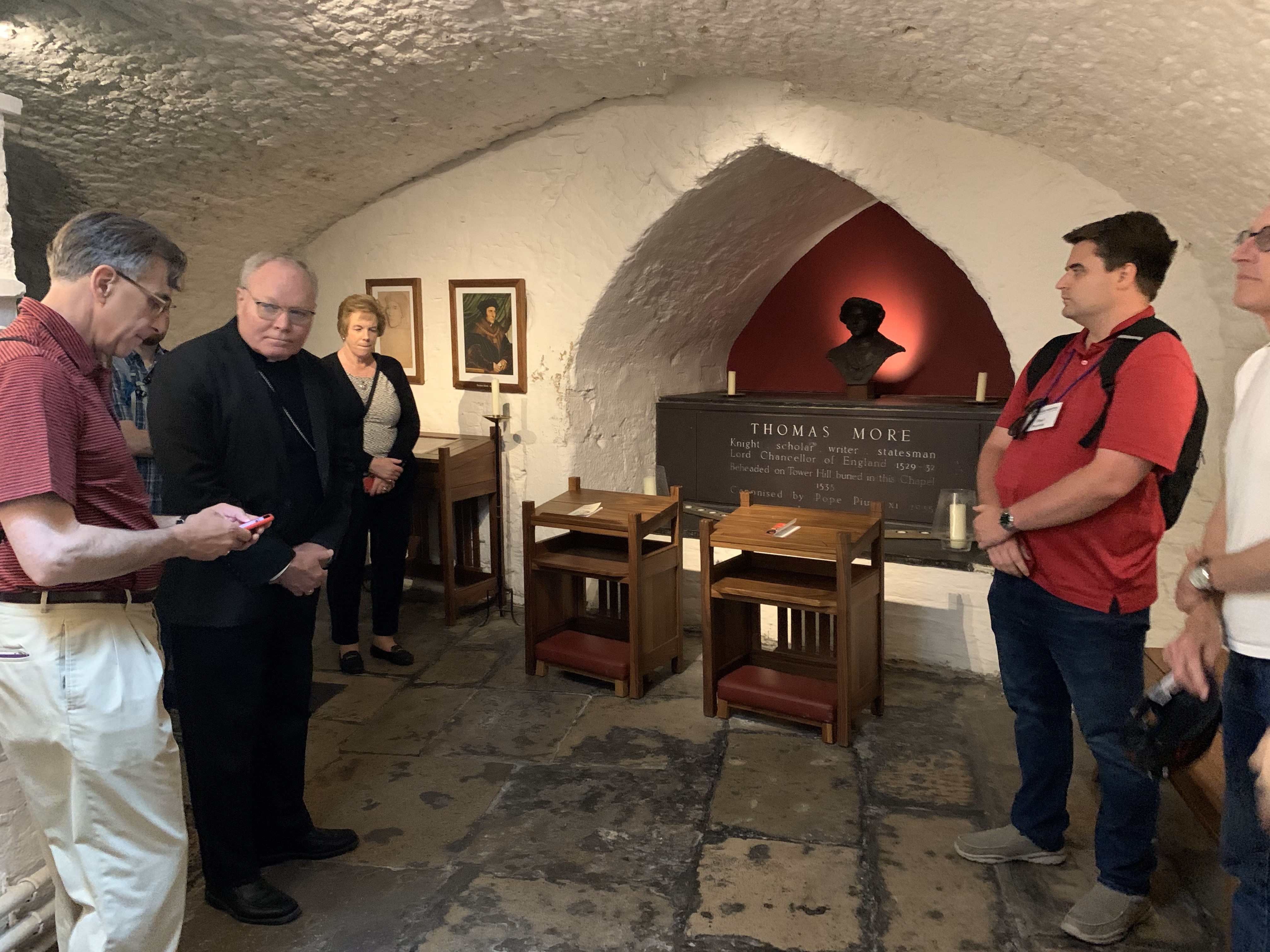 On Monday, June 19, we delved into the darkest period in Thomas More’s life, his incarceration, trial, and execution.
On Monday, June 19, we delved into the darkest period in Thomas More’s life, his incarceration, trial, and execution.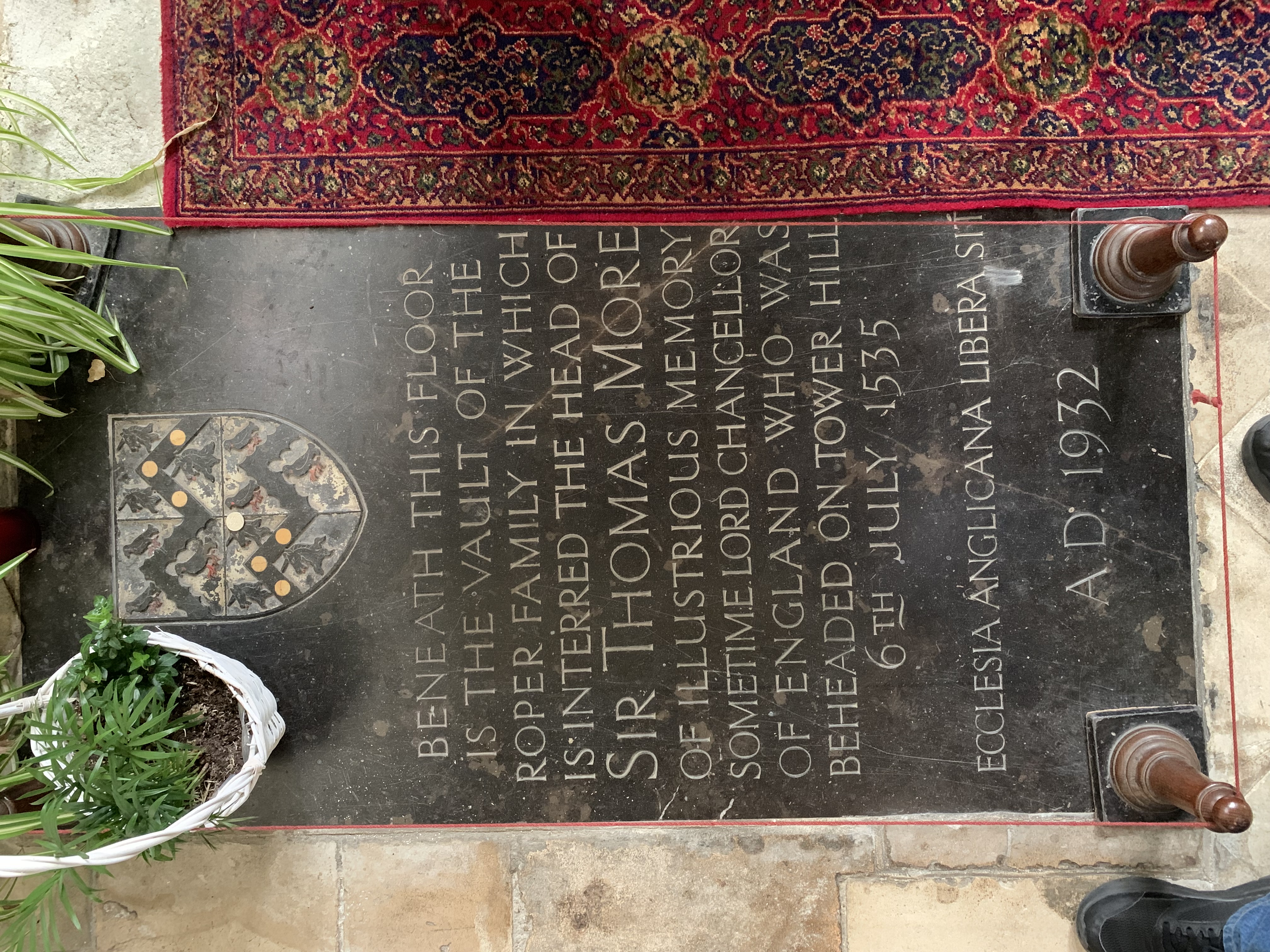 The day’s excursion took us to Canterbury, where we encountered the life and martyrdom of St. Thomas à Becket. The parallels between Becket and More, although they died 365 years apart, were palpable as we toured Canterbury Cathedral with its martyrdom site, former site of the Becket Shrine (the Shrine, itself, having been removed by King Henry VIII), and its panels of “Miracle Windows” that attest the many miracles wrought through the Holy Blissful Martyr’s intercession. The connection to More was made immediate by our visit to St. Dunstan’s in the village of Canterbury, which for many years was the Roper Family’s parish church. Although it remains Anglican, St. Dunstan’s is unabashed in its affirmation that it is the final resting place of St. Thomas More’s head. His beloved daughter, Lady Margaret Roper, retrieved it sometime after the execution and brought it thence for proper burial.
The day’s excursion took us to Canterbury, where we encountered the life and martyrdom of St. Thomas à Becket. The parallels between Becket and More, although they died 365 years apart, were palpable as we toured Canterbury Cathedral with its martyrdom site, former site of the Becket Shrine (the Shrine, itself, having been removed by King Henry VIII), and its panels of “Miracle Windows” that attest the many miracles wrought through the Holy Blissful Martyr’s intercession. The connection to More was made immediate by our visit to St. Dunstan’s in the village of Canterbury, which for many years was the Roper Family’s parish church. Although it remains Anglican, St. Dunstan’s is unabashed in its affirmation that it is the final resting place of St. Thomas More’s head. His beloved daughter, Lady Margaret Roper, retrieved it sometime after the execution and brought it thence for proper burial. 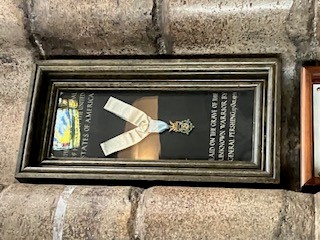 The pilgrims remained in London this day, with Westminster Abbey as our primary objective. As the Abbey is, inter alia, the royal church, the burial site of Edward the Confessor and his successors, and home to Poet’s Corner, it is hard to sum it up in a brief message, but this pilgrim was perhaps most moved by the final resting place of Britain’s unknown soldier of World War I. His remains were selected by a blind-folded general officer, escorted by sea and through the streets of London in a manner befitting a fallen head of state, and laid to rest near the entrance to the Abbey. Alone among the Abbey’s many memorials, it is forbidden to step on this grave. In a gesture of transatlantic comity, the U.S. Government awarded this individual the Medal of Honor.
The pilgrims remained in London this day, with Westminster Abbey as our primary objective. As the Abbey is, inter alia, the royal church, the burial site of Edward the Confessor and his successors, and home to Poet’s Corner, it is hard to sum it up in a brief message, but this pilgrim was perhaps most moved by the final resting place of Britain’s unknown soldier of World War I. His remains were selected by a blind-folded general officer, escorted by sea and through the streets of London in a manner befitting a fallen head of state, and laid to rest near the entrance to the Abbey. Alone among the Abbey’s many memorials, it is forbidden to step on this grave. In a gesture of transatlantic comity, the U.S. Government awarded this individual the Medal of Honor. 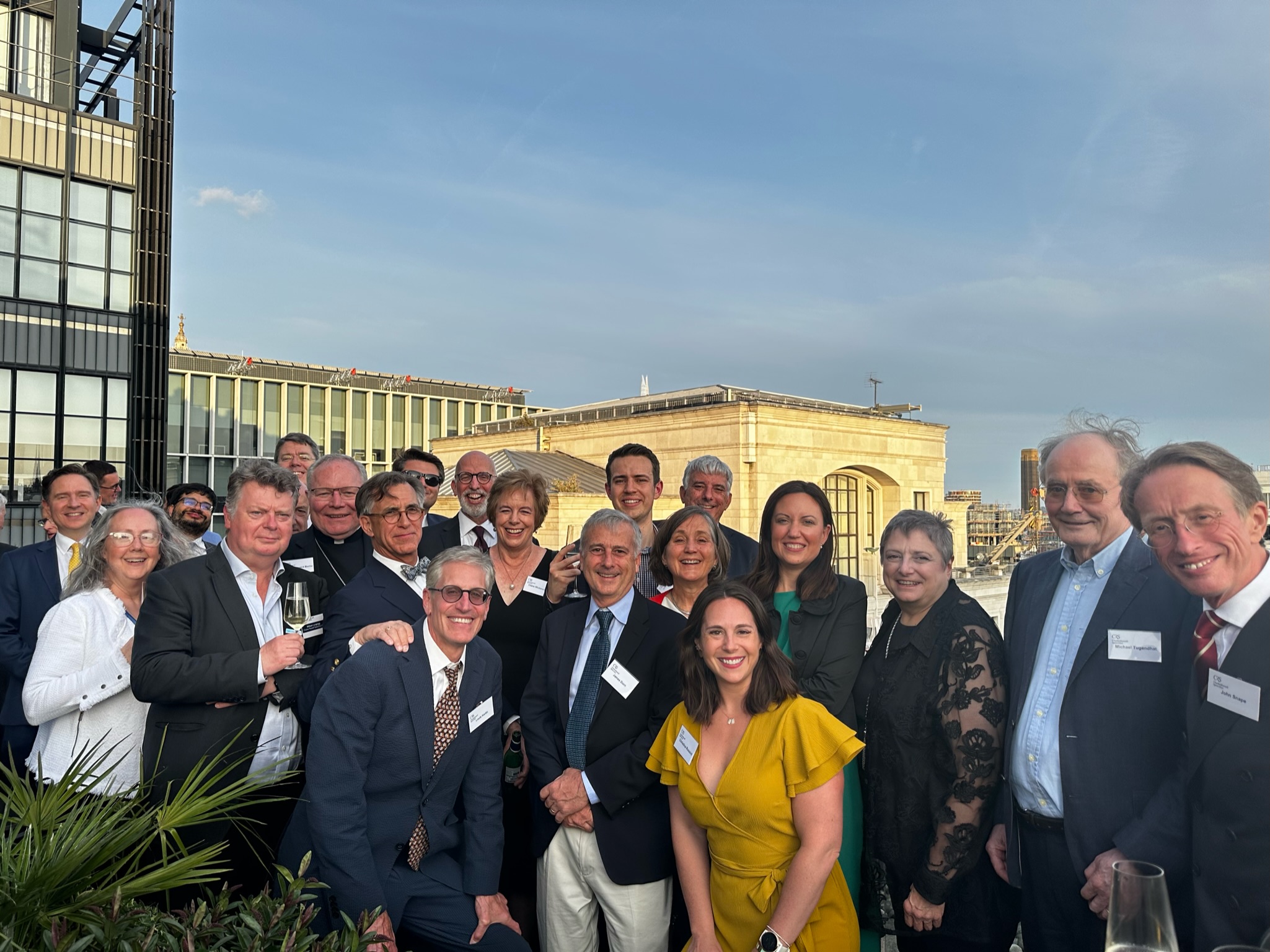 Speaking of transatlantic comity, the day ended with a rooftop cocktail reception with the St. Thomas More Society of Greater London, where our British friends proved to be every bit as gregarious as our Texas-predominant delegation. In convivial conversations, we shared perspectives on: legal education; the practice of the law; the political, religious, and legal situations in our respective countries; and the need to maintain close ties between our two organizations. I have great confidence that this goal will be attained.
Speaking of transatlantic comity, the day ended with a rooftop cocktail reception with the St. Thomas More Society of Greater London, where our British friends proved to be every bit as gregarious as our Texas-predominant delegation. In convivial conversations, we shared perspectives on: legal education; the practice of the law; the political, religious, and legal situations in our respective countries; and the need to maintain close ties between our two organizations. I have great confidence that this goal will be attained. 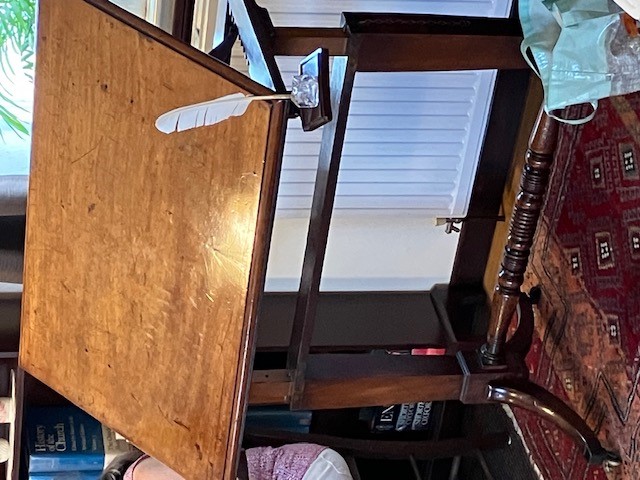 Later that day, we travelled to Littlemore College where Newman and a group of like-minded members of the Oxford Movement lived in community while discerning their conversions. Our small band of pilgrims were grateful for the opportunity to visit the very rooms where Newman prayed, studied, and wrote in the period immediately preceding his conversion on October 9, 1845. We felt a sense of awe on viewing the humble writing table which he used during his first years at Littlemore and which served as the altar for his first Mass as a Catholic priest immediately after his conversion.
Later that day, we travelled to Littlemore College where Newman and a group of like-minded members of the Oxford Movement lived in community while discerning their conversions. Our small band of pilgrims were grateful for the opportunity to visit the very rooms where Newman prayed, studied, and wrote in the period immediately preceding his conversion on October 9, 1845. We felt a sense of awe on viewing the humble writing table which he used during his first years at Littlemore and which served as the altar for his first Mass as a Catholic priest immediately after his conversion.  We next traveled to Windsor to visit the iconic Windsor Castle, now sometime home to King Charles III and his family. Like many visitors to Windsor, we were surprised by the number of great masterpieces of Western art that are included in the King’s vast collection. It was especially startling to see the famous Hans Holbein depiction of King Henry VIII wearing an ornate ring containing a large ruby which we knew to have been confiscated from the St. Thomas à Becket Shrine in Canterbury. It seemed as if Henry were determined to punish dissent even across the centuries. Before our return to London, Bishop Burns offered the final Mass of the pilgrimage at St. Edward and St. Mark in Windsor, the local Catholic church for this small, but highly significant, English village. Bishop Burns challenged the pilgrims in his final homily to continue “unpacking” what we had learned and experienced on the pilgrimage in the months to come.
We next traveled to Windsor to visit the iconic Windsor Castle, now sometime home to King Charles III and his family. Like many visitors to Windsor, we were surprised by the number of great masterpieces of Western art that are included in the King’s vast collection. It was especially startling to see the famous Hans Holbein depiction of King Henry VIII wearing an ornate ring containing a large ruby which we knew to have been confiscated from the St. Thomas à Becket Shrine in Canterbury. It seemed as if Henry were determined to punish dissent even across the centuries. Before our return to London, Bishop Burns offered the final Mass of the pilgrimage at St. Edward and St. Mark in Windsor, the local Catholic church for this small, but highly significant, English village. Bishop Burns challenged the pilgrims in his final homily to continue “unpacking” what we had learned and experienced on the pilgrimage in the months to come. 